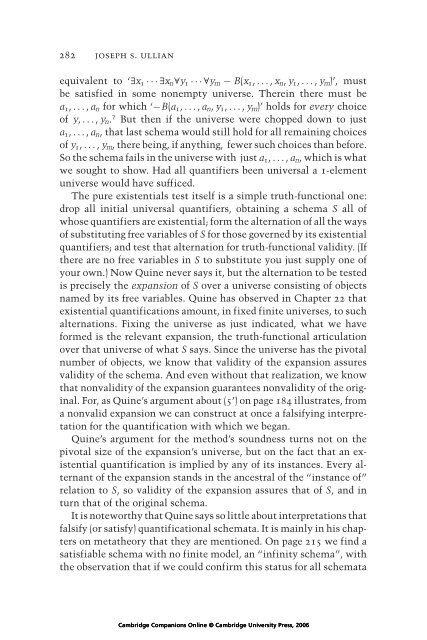Willard Van Orman Quine
Willard Van Orman Quine
Willard Van Orman Quine
Create successful ePaper yourself
Turn your PDF publications into a flip-book with our unique Google optimized e-Paper software.
282 joseph s. ullian<br />
equivalent to ‘∃x1 ···∃xn∀y1 ···∀ym − B(x1, ..., xn, y1, ..., ym)’, must<br />
be satisfied in some nonempty universe. Therein there must be<br />
a1, ..., an for which ‘−B(a1, ..., an, y1, ..., ym)’ holds for every choice<br />
of y, ..., yn. 7 But then if the universe were chopped down to just<br />
a1, ..., an, that last schema would still hold for all remaining choices<br />
of y1, ..., ym, there being, if anything, fewer such choices than before.<br />
So the schema fails in the universe with just a1, ..., an, which is what<br />
we sought to show. Had all quantifiers been universal a 1-element<br />
universe would have sufficed.<br />
The pure existentials test itself is a simple truth-functional one:<br />
drop all initial universal quantifiers, obtaining a schema S all of<br />
whose quantifiers are existential; form the alternation of all the ways<br />
of substituting free variables of S for those governed by its existential<br />
quantifiers; and test that alternation for truth-functional validity. (If<br />
there are no free variables in S to substitute you just supply one of<br />
your own.) Now <strong>Quine</strong> never says it, but the alternation to be tested<br />
is precisely the expansion of S over a universe consisting of objects<br />
named by its free variables. <strong>Quine</strong> has observed in Chapter 22 that<br />
existential quantifications amount, in fixed finite universes, to such<br />
alternations. Fixing the universe as just indicated, what we have<br />
formed is the relevant expansion, the truth-functional articulation<br />
over that universe of what S says. Since the universe has the pivotal<br />
number of objects, we know that validity of the expansion assures<br />
validity of the schema. And even without that realization, we know<br />
that nonvalidity of the expansion guarantees nonvalidity of the original.<br />
For, as <strong>Quine</strong>’s argument about (5’) on page 184 illustrates, from<br />
a nonvalid expansion we can construct at once a falsifying interpretation<br />
for the quantification with which we began.<br />
<strong>Quine</strong>’s argument for the method’s soundness turns not on the<br />
pivotal size of the expansion’s universe, but on the fact that an existential<br />
quantification is implied by any of its instances. Every alternant<br />
of the expansion stands in the ancestral of the “instance of”<br />
relation to S, so validity of the expansion assures that of S, and in<br />
turn that of the original schema.<br />
It is noteworthy that <strong>Quine</strong> says so little about interpretations that<br />
falsify (or satisfy) quantificational schemata. It is mainly in his chapters<br />
on metatheory that they are mentioned. On page 215 we find a<br />
satisfiable schema with no finite model, an “infinity schema”, with<br />
the observation that if we could confirm this status for all schemata<br />
Cambridge Companions Online © Cambridge University Press, 2006
















